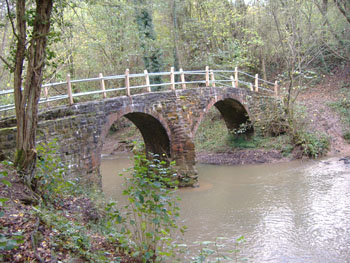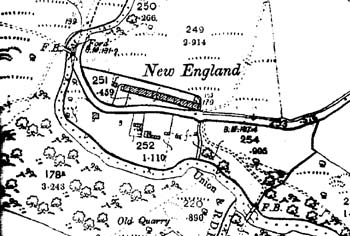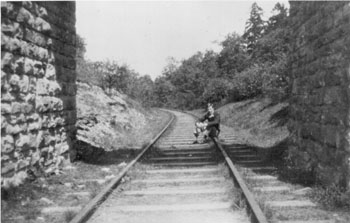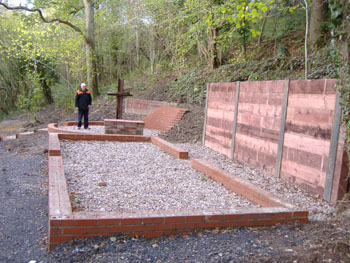The Donkey Bridge
 (The "Donkey Bridge", first shown as the
(The "Donkey Bridge", first shown as the
"New Bridge" on a map of 1754)
As part of the Local Heritage Initiative grant for New England, the history of the site is being documented. I want to deal with the Donkey or Horse Bridge, the oldest feature of the site.
The bridge is a narrow, two arch structure built of local sandstone but with the arches lined with brick. The central pier forms a substantial cut-water, to deflect the water of the Borle Brook through the two arches. The narrow deck of the bridge shows that it was only ever intended for pedestrians or horses in single file and the alternative names for the bridge both reflect the local tradition that it was used for packhorses.
The earliest map that shows Highley in any detail is a map of Shropshire drawn up in 1754 by a cartographer called Jean Roque. The bridge is marked on this and called the “New Bridge”. This suggests that it was built in the early 18th century; a date also suggested by its style (particularly the use of bricks, which do not seem to have been much used in this area until the end of the 17th century). There is an entry in the Poor Rates for 1742, noting that money was spent repairing Malpass Mill bridge (leading to Kinlet and long defunct) and the New Bridge. This is the earliest contemporary reference to the bridge.
Writing at the start of the 19th century, the vicar of Kinlet, the Rev Blakeway, described the bridge as “very ancient and almost ruinous”, although it was still called the “New Bridge”. Blakeway preserves an intriguing story as to its origins. In 1709, the country was controlled by a Whig government; the Whigs were the ancestors of the Liberal party of today. In that year, a clergyman called Dr Henry Sacheverall preached two sermons attacking Government policy, particularly their tolerance of non-conformists. The Government arrested Sacheverall and put him on trial for seditious libel. The trial provoked riots in London and the House of Lords, whilst finding Sacheverall guilty, imposed a token sentence, preventing him from preaching for three years and ordering the public hangman to burn a copy of the offending sermons. The government was humiliated and, already unpopular for other reasons, soon fell to be replaced by a Tory administration. Sacheverall was offered a new post at Selattyn in North Shropshire and made what was effectively a triumphal procession from London to take up his benefice in 1710. Blakeway records how at Kinlet, the squire, Sir Lacon William Childe, invited him to stay. New Bridge was said to have been built for Sacheverall’s use and he was greeted by a crowd of 2000 on a flat space near the bridge.
It is difficult to know how reliable this story is; presumably Blakeway obtained his information from the members of Childe family in his own day. There is no doubt that the family and much of the surrounding country would have been in sympathy with Sacheverall. Blakeway gave two examples of local people who were given the Christian name “Sacheverall”, apparently in honour of Dr Sacheverall.
Regardless of the truth of the story, the bridge would have been used from the start by those who wished to cross the Borle Brook to reach riverside wharfs and crossings in Highley and Hampton Loade. As noted in an earlier article, there was no shortage of trade from the Rea Valley and the Clee Hills that needed to get to the Severn. It is possible to trace the old road, now a public footpath, that drops steeply down the hillside from Crumpsend Farm to Bind Brook and then follows this a short distance to the Donkey Bridge. On the Highley side, the path immediately from the end of the bridge seems to be on a causeway and there are traces of what may be a track going straight up the hillside. This may be the original road leading from the Bridge.
On the Highley bank of the brook, next to the Donkey Bridge, are traces of stone blocks in the bank; it is possible that these represent an earlier bridge at this point.
New England Cottages
 (The 1902 OS map showing a row of
(The 1902 OS map showing a row of
cottages at New England)
In the undergrowth, by the side of the road at New England, can be made out the foundations of a row of 11 stone cottages; almost all that is left of the small settlement that once flourished down there. Today New England is a quiet isolated spot, but at the start of the 19th century it was very different. Coal mines and a blast furnace were at work in Billingsley, in the fields close to the Cape of Good Hope, and a horse-worked tramway was busy moving the products of these enterprises to the Severn in Highley. The tramway followed the Borle Brook and so New England would have been a busy place.
The industry in Billingsley caused its population to quadruple in size and cottages must have sprung up everywhere. The owners of the colliery had bought land at New England when the mines first started working in 1794 and it was probably in 1807 they decided it would be a good place to build some houses. The inhabitants would be faced with a 20 minute uphill walk each day to get to work, but that would not have been considered any great hardship. It seems that initially about 16 cottages were built; a row of perhaps 10 facing the road and another row of 6 at right angles to it, on the flat land to the north of the road between it and the brook. Unfortunately, the mines at Billingsley closed in 1812 and in that year the majority of the cottages were empty. Expansion at another mine in Highley ensured that numbers recovered, but when that also closed in 1823 the population of the whole area shrank. The cottages must have been damp and isolated and were not attractive propositions. By 1841 it seems only six families were living there. At this stage at least part of the second terrace at right angles to the road was still standing. However, the decline in population continued and by 1851 if it was still standing it must have been ruinous, as the census enumerator recorded only five dwellings occupied with another five empty. At about this time the landowner, Edwin Evans, pulled down three houses, perhaps the last remains of the second terrace but also built another house, presumably on the end of the row parallel to the road. The original houses each appear to have been about 20’x 22’, making them very small. It is possible that during the mid-nineteenth century, a family might have occupied more that one of the original cottages to give themselves more space. In 1870 mining started again at Billingsley and the next year there were 9 families in the houses. With the opening of Highley Colliery in 1878 the area began to grow rapidly and suddenly the old cottages at New England were once again in demand. In 1881 all eleven were occupied, with three lodgers living there in addition to the families. In 1901 they were bursting; 66 individuals were crammed into the terrace; an average of two people per room or 8 sq yards of floor space per person.
Gradually, new houses were built in Highley, first in the village, then at Garden Village and these must have helped take the pressure off New England. Mrs Davies, of Wilkins Close, was born in New England and recalls 8 families living there during the First World War. She remembers it being very quiet, with only a few horse and carts passing by along the road. Water came from a spring on the other side of the brook. It was eventually the construction of houses in Garden Village that brought about the demise of New England. The land opposite was used for a sewage works and in 1917 the District Council condemned the houses. Some moved into the Streets in the village, but Mrs Davies’ family with others went to Clee View. They were moved by horses and waggon belonging to Jim Breakwell, a local haulier. The cottages were demolished but for many years served as an unofficial quarry for anyone who wanted stone.
The first railway to Billingsley
 (The track of the railway to Billingsley Colliery, showing an overbridge between Borle Mill and New England. The photograph was probably taken in the 1930’s.).
(The track of the railway to Billingsley Colliery, showing an overbridge between Borle Mill and New England. The photograph was probably taken in the 1930’s.).
Many people will be aware that there was a coal mine at Billingsley. Whilst founded in the 19th century, this was at its busiest in the years around the First World War, when it employed over 200 men. To serve the mine, a railway was constructed from the Severn Valley Railway at Kinlet, alongside the Borle Brook to New England. From there a spur followed Bind Brook to Priors Moor where a narrow gauge ropeway brought tubs from the mine to discharge into railway wagons. This line opened in 1913. Whilst Billingsley Colliery closed in 1921, the railway remained operational until 1937, to serve a coal wharf at Priors Moor. The track bed of this railway and some of the bridges survive largely intact and much of it is a public right-of-way.
This railway is fairly well known, at least locally; some can still recall it working. However, what is much less well known is that it largely followed the route of a line that was begun some 30 years earlier in 1880. The mine at Billingsley was sunk at the start of the 1870’s. A public limited company, the Billingsley Colliery Company, was formed in 1875 to work it. This had great plans for the mine; to bring these about it was essential for it to be linked to the Severn Valley Railway and hence the national rail network.
The first step in building a railway was to get the necessary permissions for the track to cross private land. The colliery stood on land in Billingsley belonging to the Duke of Cleveland, but it was not until March 1877 that a lease was signed, giving permission for the railway as well as granting extra mineral rights. In Kinlet the land belonged to William Lacon Childe; he gave permission in February 1878. Finally, in December 1878, the Great Western Railway agreed to allow a connection to the Severn Valley line.
A railway cannot be built unless the promoters have sufficient money. The Billingsley Colliery Company appeared to experience pecuniary and other problems in the late 1870’s. Their one-time chairman was imprisoned to six months hard labour for fraud and one of the principal share-holders agreed to invest £10,000 to provide capital for the railway. He was subsequently less than forthcoming with this cash and at the end of 1878 the company was purchased by Samuel Norton Dimbleby. The next year Dimbleby renamed it the Severn Valley Colliery Company and by various means (I suspect of dubious character), he apparently had raised enough money to allow construction of the railway to begin.
On Monday 25th October 1880, a Colonel Stallard cut the first sod of the railway in front of the company shareholders, representatives of the GWR and invited guests. For what was simply a private mineral railway, this was an elaborate proceeding, but I suspect Dimbleby was not averse to publicity. The party then traced the route of the railway to the colliery and lunch and the usual speeches. The line followed the course of the later Billingsley Railway as far as New England. There it was to continue alongside the Borle Brook for a short distance before striking due west to reach the colliery by a chain-worked incline, over half a mile long.
The line was due to be completed by the end of January and open by 31st March. This was an ambitious target but the contractors, Messrs Drewitt and Pickering of Stoke on Trent, seem to have made good progress, quickly constructing all the earthworks as far as New England. Then work stopped. Work stopped almost certainly because their money stopped. My suspicion is that Dimbleby and the company never had enough money to pay for the completion of the line.
Over the next two years, Dimbleby promoted two more companies to take over the colliery and complete the railway. Neither succeeded. Finally, in October 1882, the materials on the line were sold, probably by Drewitt and Pickering in an attempt to get some of their money back.
All the effort of the 1880s was not ultimately wasted. Much of the 1913 Billingsley Railway from Kinlet to New England used the earthworks built by Drewitt and Pickering.
New England sewage works
 (This sewage treatment plant was built just before the First World War. It consisted of two brick tanks, one probably a settling tank and the other a filtration tank. A piece of tram rail was adapted, perhaps as sprinkler for one of the tanks. The site has recently been conserved.)
(This sewage treatment plant was built just before the First World War. It consisted of two brick tanks, one probably a settling tank and the other a filtration tank. A piece of tram rail was adapted, perhaps as sprinkler for one of the tanks. The site has recently been conserved.)
One of the objects of the New England enhancement scheme is to conserve the remains of the sewage works that stand overlooking the Donkey Bridge.
Why on earth should anyone want to save a sewage works? There are several reasons. One is very practical. Whenever I take people around New England, the remains always cause interest; brick foundations, a stone retaining wall and a curious metal pole with a hoop around it. Only locals know what it actually was; most think it was something to do with the railways or the mines. The remains are striking and they are part of the history of the site.
Perhaps there are other reasons why we should care about an old sewage works. Life expectancy has more-or-less doubled over the last 100 to 150 years. This has virtually nothing to do with advances in clinical medicine. In fact it is largely due to improvements in public health and hygiene. We no longer live in terror of diseases such as cholera and yet 150 years ago most people could expect to die from some form of infectious disease. One of the reasons why infectious diseases have largely died out is because of clean water. We owe our health to sewage works.
Infectious diseases go hand-in-hand with large numbers of people. At the start of the nineteenth century, when mines trebled the population of Billingsley, mortality soared and the average age at death was around 15. A hundred years later, when the Billingsley Colliery Company built Clee View and Garden Village for miners at their pit, there was barely a blip in the death rate. The reason for this was that the Colliery Company was forced to provide a proper sewage scheme for their houses. This was built at New England. A little more than 10 years before the Highley Mining Company, when building the Streets in the village centre, had been able to get away with ash pits and the visits of the night soil cart to deal with what might politely be termed “human waste”. Whilst reasonably effective for small communities if done properly, it was hardly in line with best practice. The Billingsley Colliery Company built a modern plant with a settlement tank and filter beds to allow bacteria to break down the sewage before it was discharged into the brook.
The New England sewage works ended up as an epic saga, taking almost 10 years and two companies to complete. The Billingsley Colliery began by building Clee View; in 1913 they bought a small patch of land at New England for their sewage works. The present ruins appear to be the filtration beds; the settlement tank is much higher up the bank, forming a well. Shortly afterwards, work began on Garden Village. The company seemed to hope the District Council would take over the sewage works, but in this they were to be sadly disappointed. Not only did the District refuse to take over the scheme, they insisted the Company expand it to accommodate the new houses at Garden Village. It seems the original works were obsolete almost as soon as they were finished. A larger works were started a little to the north-west of the old works in 1915. Almost immediately this had been done, the Billingsley company sold out to the Highley Mining Company who inherited the sewage works as well as Billingsley Colliery. It was now deep in wartime, Garden Village was not a priority and little was done until 1919. The works were not finished until the spring of 1920, at which time the new houses in Garden Village were declared fit for habitation by the council and the old works were closed. The sewage works operated until about 1950, when it was replaced by one at Wrens Nest.
The New England works reflect the great advances in public health and also the battles between the District Council and developers 90 years ago. Sewage works can be interesting!
The New England Enhancement is funded by the Local Heritage Initiative, a partnership between the Heritage Lottery Fund, Nationwide Building Society and the Countryside Agency.
New England revisited
Last year, the Highley Initiative, in partnership with Bridgnorth District Council, commissioned an archaeological investigation of the former cottages at New England. A group of volunteers led by professional archaeologist Tony Hanna uncovered what we thought was the end cottage in the terrace. This turned out to be 20’ x 21’ and divided into two rooms by a brick partition wall.
The room to the west was much narrower than the east one; it had a brick floor and seemed to have held the stairs to the first floor, perhaps also contained a pantry. The main room had a large fireplace, originally stone but modified with bricks to hold a cooking range. It had a quarry tile floor, although most of these had been lifted.
We were surprised to find there was a room to the east of this cottage; it was obviously not the end of the terrace as we first thought. As a consequence of this discovery, we invited Tony to return and in the first two weeks of August he and a number of volunteers investigated this mystery building. The excavation proved much harder than last year, as the remains were covered by up to 5 feet of rubble and in addition there were some substantial tree roots in the way. However, by the end of the fortnight, we had a clear idea of the function of the building.
At the start of the excavation, we knew that the building had a brick floor and was apparently accessed by a door leading to the back alley behind all the cottages. We also had found another door between it and the cottage we excavated last year. Our first thoughts were that the building might have been a stable. In 1871 William Walford was living at “Highley Wood Farm”; we suspected this might have been a small-holding, with William living in one of the New England cottages and having a stable next door.
This theory started to look less plausible when excavations of the front wall uncovered the remains of a drain and the mounting for a sink. Even the most superior stable was unlikely to have a wash-basin. On that basis, we considered whether the building might have been a communal washroom. As the cottage next door did not seem to have a sink, we wondered whether, when the terrace had first been built, the end building had been the only one to have a sink and a boiler.
Such arrangements were common in the 19th century; the residents would have shared the room when they needed to wash clothes and brew beer. The room was also whitewashed, not plastered as the cottage next door had been; perhaps consistent with it being less important. However, this was not entirely convincing. The bricks used to build the mounting for the sink looked no later than c1900; they were certainly not from 1807, when the cottages were built.
Over the next few days, our trenches followed the walls east, until we hit the end of the building. It turned out to be slightly larger than the adjoining cottage. Exploring the gable-end wall, we first found what we thought was another mounting for a sink. However, we changed our minds when we discovered it was next to a substantial chimney and fireplace; soot-blackening confirmed this was originally a boiler heated by the fire.
Further work in the archives helped us decide the function of the building. It became apparent that as demand for accommodation went up and down in Highley, the cottages at New England were either let on their own or as pairs to one family. Our building had started life as one of the normal cottages in the terrace. It had been quite extensively rebuilt at some point in the middle of the 19th century and was occupied as a single cottage in 1901, when there was an acute housing shortage in Highley.
However, by 1912 this had largely been solved by new house building. At this point, the cottage had been converted to an annexe to the one next door and a connecting door installed. It became the kitchen, with a sink and a boiler for hot water, allowing the occupants to have the luxury of a separate living room. In 1917 both buildings were demolished when the entire terrace was condemned.


